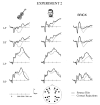Material-specific neural correlates of recollection: objects, words, and faces
- PMID: 20146595
- PMCID: PMC3202170
- DOI: 10.1162/jocn.2010.21442
Material-specific neural correlates of recollection: objects, words, and faces
Abstract
It is unclear how neural correlates of episodic memory retrieval differ depending on the type of material that is retrieved. Here, we used a source memory task to compare electrical brain activity for the recollection of three types of stimulus material. At study, healthy adults judged how well visually presented objects, words, and faces fitted with paired auditorily presented names of locations. At test, only visual stimuli were presented. The task was to decide whether an item had been presented earlier and, if so, what location had been paired with the item. Stimulus types were intermixed across trials in Experiment 1 and presented in separate study-test lists in Experiment 2. A graded pattern of memory performance was observed across objects, words, and faces in both experiments. Between 300 and 500 msec, event-related potentials for recollected objects and faces showed a more frontal scalp distribution compared to words in both experiments. Later in the recording epoch, all three stimulus materials elicited recollection effects over left posterior scalp sites. However, these effects extended more anteriorly for objects and faces when stimulus categories were blocked. These findings demonstrate that the neural correlates of recollection are material specific, the crucial difference being between pictorial and verbal material. Faces do not appear to have a special status. The sensitivity of recollection effects to the kind of experimental design suggests that, in addition to type of stimulus material, higher-level control processes affect the cognitive and neural mechanisms underlying episodic retrieval.
Figures





References
-
- Allison T, Puce A, Spencer DD, McCarthy G. Electrophysiological studies of human face perception I: Potentials generated in occipitotemporal cortex by face and non-face stimuli. Cerebral Cortex. 1999;9:415–430. - PubMed
-
- Curran T. Brain potentials of recollection and familiarity. Memory and Cognition. 2000;28:923–938. - PubMed
-
- Curran T, Cleary AM. Using ERPs to dissociate recollection from familiarity in picture recognition. Cognitive Brain Research. 2003;15:191–205. - PubMed
Publication types
MeSH terms
Grants and funding
LinkOut - more resources
Full Text Sources

